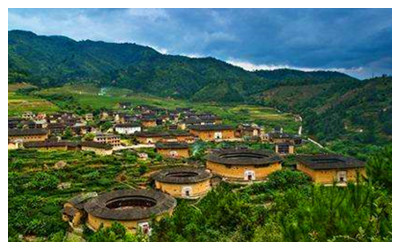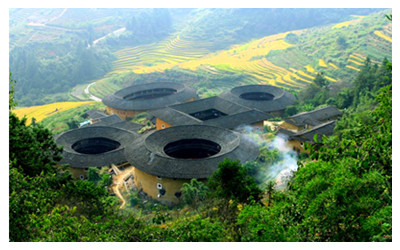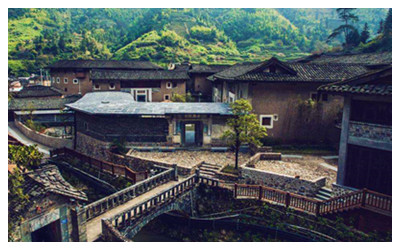Tulou means 'earth building'. It is named from its outer walls, which are made from rammed earth. Generally speaking, the large multi-storey Tulou was seldom seen in the areas where early Hakka lived. However, they are appeared in the perimeters of Hakka and other ethnic groups or around locations where Hakka fast developed after Ming and Qing dynasties.
History of Tulou
Hakkas are the Owner of Earthen Buildings. Hakka, literally, means 'guest' in Chinese. They are not an ethnic group like the Tibetans or
Mongolians. Their nationality is Han. The ancestors of Hakkas used to live in central China and were forced to move southward due to wars, famine and political reasons. There were 5 major migrations:
From the end of the Han Dynasty to Jin Dynasty, Han people crossed the Yangtze River to avoid wars.
From the East Jin to the Five Dynasties, Han people moved further south from the Yangtze River.During the Southern Song Dynasty when the Mongolians spread rapidly southwards and the Song moved their capital to Hangzhou, the Hakkas moved from Fujian and Jiangxi to the north and east of Guangdong.
At the end of the Ming Dynasty as the Mandarin army and farmers' uprising were rampant, Hakkas moved on to central Guangdong and coastal area, also to Sichuan, Guangxi, Hunan and Taiwan with a minority going to southern Guizhou.
During the reign of the Qing Emperor Tongzhi (1862-1874), Hakkas moved on to Hainan, Taiwan, Hong Kong, Macau, South-eastern Asia and even to Europe and America as a consequence of the Taiping Tianguo uprising.
Over their long history, Hakkas have formed their own unique culture. They adhere to Confucianism and give importance to education. Often referred to as the Jews of China, Hakkas excel in many fields from academe to politics and commerce. They are spread around the world and especially in South-east Asia. Notable figures include Deng Xiao Ping, the chief designer of the opening-up and reform of modern China, Li Ka-Shing, a Hakka from Chaozhou, Guangdong Province, is the Asia's richest and most powerful man and No. 22 in the list of the World's Richest People 2005, according to Forbes. Lee Kuan-Yew, the former prime minister of Singapore, also is Hakka.
Features of Tulou
If there are only two storeys, the first floor becomes the bed-room. Most round Tulous are three or four storeys. The first floor becomes a storage room for food and furniture. The storage room does not have any windows. The second floor and above are bedrooms in this case. They have small windows, which open to the outside, and a larger widow opening to corridor. The corridors are built on the extension of the beams of the lower floor. As a result, the ground floor is free of columns, and creates a large open space. The interesting thing is the small eaves on the second or third floors. The obvious function is for drainage. However, the space created under the eaves can be used as a storage place.
Types of Tulou

The Tulous in the Fujian Province are divided into three types, Wufeng, Rectangular, and Round. Wufeng are located mainly in Yongding, and rectangular and round Tulou are distributed in Nanjing, Pinghe, Zhao’an West and Yongding East. In most of the villages, round and rectangular tulous are mixed together. Among three kinds of Tulous, the rectangular Tulous were the original ones.
Rectangular Tulou: In reality, the rectangular Tulous were built earlier than round ones. For example, in the northern part of the Guzhu, Yongding, the rectangular tulou, named Wuyun Tulou was built five or six hundred years ago, while the round shape, Chengqi had only been built for three or four hundred years.
 Round Tulou:
Round Tulou: The round Tulou has distinct characteristics. It is high, giant, and complex. Generally speaking, round Tulous can be divided into small, medium, and large types. Small round tulous are normally two or three storeys and consist of a single ring; medium round tulous are three or four storeys high and have wide diameters or two rings; large ones are four or five storeys with two rings or even three rings. A large number of round tulous are of medium size. The Tulou is occupied normally by a kin group. As a result it is more like an apartment or a small village rather than a single building.
Round Tulous normally have only one fortified door. Behind the door is the foyer. This is not only the major access, but also the public space for the occupants. The natural ventilation is ideal. No matter what size and how

many storeys of round Tulous, the room sizes are the same at the same location on each floor. The ground floor is always the kitchen.
Wufeng Tulou: The Wufeng tulous are obviously the results of a redesign of the Chinese courtyard by the Hakkas. Three halls and two side rooms' are a feature of the Wufeng tulou. The side rooms are the heightened wing-room of the Chinese courtyard. The center hall in the back yard becomes a multi-storey building. The earth walls in the four sides are enclosure. This was not only for defense reasons, but also as an expression of traditional Chinese architectural forms.
Related Interesting News about Tulou
As the shape of Tulou is special, America mistakenly assumed that it’s nuclear silo in the Cold War era. After 20-year study, American Scholars can’t still know the confidential of these 1500 nuclear silos. Finally, Central Intelligence Agency asked two staffs as visitors to Yongding County to investigate these nuclear silos. What was so astounding was that these architectures are time-honored Tulous, not nuclear silos, which made America relieve.

 The Tulous in the Fujian Province are divided into three types, Wufeng, Rectangular, and Round. Wufeng are located mainly in Yongding, and rectangular and round Tulou are distributed in Nanjing, Pinghe, Zhao’an West and Yongding East. In most of the villages, round and rectangular tulous are mixed together. Among three kinds of Tulous, the rectangular Tulous were the original ones.
The Tulous in the Fujian Province are divided into three types, Wufeng, Rectangular, and Round. Wufeng are located mainly in Yongding, and rectangular and round Tulou are distributed in Nanjing, Pinghe, Zhao’an West and Yongding East. In most of the villages, round and rectangular tulous are mixed together. Among three kinds of Tulous, the rectangular Tulous were the original ones. Round Tulou: The round Tulou has distinct characteristics. It is high, giant, and complex. Generally speaking, round Tulous can be divided into small, medium, and large types. Small round tulous are normally two or three storeys and consist of a single ring; medium round tulous are three or four storeys high and have wide diameters or two rings; large ones are four or five storeys with two rings or even three rings. A large number of round tulous are of medium size. The Tulou is occupied normally by a kin group. As a result it is more like an apartment or a small village rather than a single building.
Round Tulou: The round Tulou has distinct characteristics. It is high, giant, and complex. Generally speaking, round Tulous can be divided into small, medium, and large types. Small round tulous are normally two or three storeys and consist of a single ring; medium round tulous are three or four storeys high and have wide diameters or two rings; large ones are four or five storeys with two rings or even three rings. A large number of round tulous are of medium size. The Tulou is occupied normally by a kin group. As a result it is more like an apartment or a small village rather than a single building. many storeys of round Tulous, the room sizes are the same at the same location on each floor. The ground floor is always the kitchen.
many storeys of round Tulous, the room sizes are the same at the same location on each floor. The ground floor is always the kitchen. Ask Questions ?
Ask Questions ?